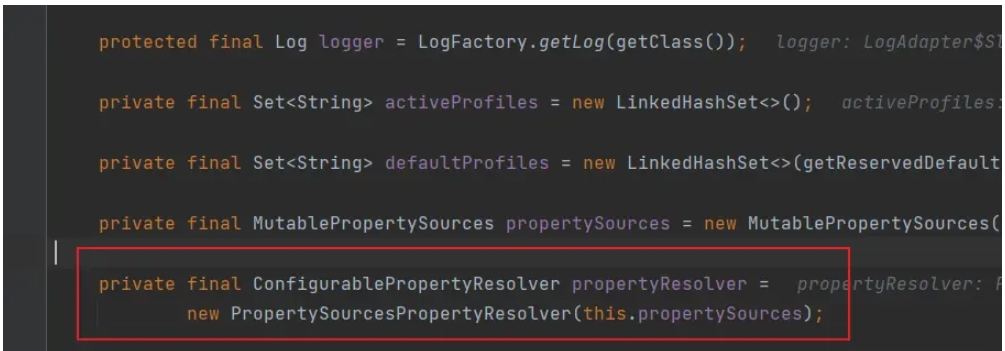您好,登錄后才能下訂單哦!
您好,登錄后才能下訂單哦!
今天小編給大家分享一下Spring refresh()源碼分析的相關知識點,內容詳細,邏輯清晰,相信大部分人都還太了解這方面的知識,所以分享這篇文章給大家參考一下,希望大家閱讀完這篇文章后有所收獲,下面我們一起來了解一下吧。
public void refresh() throws BeansException, IllegalStateException {
synchronized(this.startupShutdownMonitor) {
// 1. 初始化前的預處理
this.prepareRefresh();
// 2. 刷新Bean工廠
ConfigurableListableBeanFactory beanFactory = this.obtainFreshBeanFactory();
// 3. BeanFactory的預處理配置
this.prepareBeanFactory(beanFactory);
try {
// 4. BeanFactory的后置處理
this.postProcessBeanFactory(beanFactory);
// 5. 執行BeanFactory后置處理器
this.invokeBeanFactoryPostProcessors(beanFactory);
// 6. 注冊Bean的后置處理器
this.registerBeanPostProcessors(beanFactory);
// 7. 初始化MessageSource
this.initMessageSource();
// 8. 初始化事件派發器
this.initApplicationEventMulticaster();
// 9. 子類的多態onRefresh
this.onRefresh();
// 10. 注冊監聽器
this.registerListeners();
// 11. 初始化所有剩下的單例Bean
this.finishBeanFactoryInitialization(beanFactory);
// 12. 完成容器的創建工作
this.finishRefresh();
} catch (BeansException var9) {
if (this.logger.isWarnEnabled()) {
this.logger.warn("Exception encountered during context initialization - cancelling refresh attempt: " + var9);
}
this.destroyBeans();
this.cancelRefresh(var9);
throw var9;
} finally {
// 13. 清除緩存
this.resetCommonCaches();
}
}
}protected void prepareRefresh() {
//設置容器啟動時間
this.startupDate = System.currentTimeMillis();
//設置容器關閉狀態為false
this.closed.set(false);
//設置容器激活狀態為true
this.active.set(true);
if (this.logger.isDebugEnabled()) {
if (this.logger.isTraceEnabled()) {
this.logger.trace("Refreshing " + this);
} else {
this.logger.debug("Refreshing " + this.getDisplayName());
}
}
//1.1初始化屬性資源
this.initPropertySources();
//1.2校驗
this.getEnvironment().validateRequiredProperties();
this.earlyApplicationEvents = new LinkedHashSet();
}初始化方法是個模壓方法,由子類重寫
protected void initPropertySources() {
}Web容器GenericWebApplicationContext重寫了此方法
protected void initPropertySources() {
//獲取環境信息
ConfigurableEnvironment env = getEnvironment();
//判斷是否是web配置環境
if (env instanceof ConfigurableWebEnvironment) {
((ConfigurableWebEnvironment) env).initPropertySources(this.servletContext, null);
}
}最終由StandardServletEnvironment進行初始化
public void initPropertySources(@Nullable ServletContext servletContext, @Nullable ServletConfig servletConfig) {
//使用web容器工具初始化
WebApplicationContextUtils.initServletPropertySources(getPropertySources(), servletContext, servletConfig);
}把 Servlet 的一些初始化參數放入IOC容器中
public static void initServletPropertySources(MutablePropertySources sources, @Nullable ServletContext servletContext, @Nullable ServletConfig servletConfig) {
Assert.notNull(sources, "'propertySources' must not be null");
String name = "servletContextInitParams";
if (servletContext != null && sources.contains(name) && sources.get(name) instanceof StubPropertySource) {
sources.replace(name, new ServletContextPropertySource(name, servletContext));
}
name = "servletConfigInitParams";
if (servletConfig != null && sources.contains(name) && sources.get(name) instanceof StubPropertySource) {
sources.replace(name, new ServletConfigPropertySource(name, servletConfig));
}
}通過占位符解析器校驗資源集合
public void validateRequiredProperties() throws MissingRequiredPropertiesException {
this.propertyResolver.validateRequiredProperties();
}這里的解析器作為常量在環境被實例化時就被創建出來的,PropertySourcesPropertyResolver是占位符解析器,將數據源中占位符替換成目標值

校驗是否有需要被占位符修飾的屬性,如果有但是資源中找不到對應屬性的key就會拋出異常
public void validateRequiredProperties() {
MissingRequiredPropertiesException ex = new MissingRequiredPropertiesException();
for (String key : this.requiredProperties) {
if (this.getProperty(key) == null) {
ex.addMissingRequiredProperty(key);
}
}
if (!ex.getMissingRequiredProperties().isEmpty()) {
throw ex;
}
}案例: 資源文件
name=zhansan
age=${name},10
encoding=utf-8
name2=${name}測試代碼
@Test
public void test1() throws Exception {
//省略propertySources
PropertyResolver propertyResolver = new PropertySourcesPropertyResolver(getPropertySources());
System.out.println(propertyResolver.getProperty("age"));
System.out.println(propertyResolver.getProperty("encoding"));
System.out.println(propertyResolver.resolvePlaceholders("must be encoding ${encoding}")); //輸出must be encoding gbk
}輸出結果
10,zhansan
utf-8
must be encoding utf-8
protected ConfigurableListableBeanFactory obtainFreshBeanFactory() {
//2.1刷新Bean工廠
refreshBeanFactory();
return getBeanFactory();
}將容器刷新標識改為true,并且設置了工廠序列化id
protected final void refreshBeanFactory() throws IllegalStateException {
if (!this.refreshed.compareAndSet(false, true)) {
throw new IllegalStateException(
"GenericApplicationContext does not support multiple refresh attempts: just call 'refresh' once");
}
this.beanFactory.setSerializationId(getId());
}protected void prepareBeanFactory(ConfigurableListableBeanFactory beanFactory) {
// 設置BeanFactory的類加載器、表達式解析器等
beanFactory.setBeanClassLoader(getClassLoader());
beanFactory.setBeanExpressionResolver(new StandardBeanExpressionResolver(beanFactory.getBeanClassLoader()));
beanFactory.addPropertyEditorRegistrar(new ResourceEditorRegistrar(this, getEnvironment()));
// 3.1 添加Aware執行器
beanFactory.addBeanPostProcessor(new ApplicationContextDProcessor(this));
beanFactory.ignoreDependencyInterface(EnvironmentAware.class);
beanFactory.ignoreDependencyInterface(EmbeddedValueResolverAware.class);
beanFactory.ignoreDependencyInterface(ResourceLoaderAware.class);
beanFactory.ignoreDependencyInterface(ApplicationEventPublisherAware.class);
beanFactory.ignoreDependencyInterface(MessageSourceAware.class);
beanFactory.ignoreDependencyInterface(ApplicationContextAware.class);
// 3.2 自動注入的支持
beanFactory.registerResolvableDependency(BeanFactory.class, beanFactory);
beanFactory.registerResolvableDependency(ResourceLoader.class, this);
beanFactory.registerResolvableDependency(ApplicationEventPublisher.class, this);
beanFactory.registerResolvableDependency(ApplicationContext.class, this);
// 3.3 添加監聽器執行器
beanFactory.addBeanPostProcessor(new ApplicationListenerDetector(this));
// Detect a LoadTimeWeaver and prepare for weaving, if found.
if (beanFactory.containsBean(LOAD_TIME_WEAVER_BEAN_NAME)) {
beanFactory.addBeanPostProcessor(new LoadTimeWeaverAwareProcessor(beanFactory));
// Set a temporary ClassLoader for type matching.
beanFactory.setTempClassLoader(new ContextTypeMatchClassLoader(beanFactory.getBeanClassLoader()));
}
// Register default environment beans.
if (!beanFactory.containsLocalBean(ENVIRONMENT_BEAN_NAME)) {
beanFactory.registerSingleton(ENVIRONMENT_BEAN_NAME, getEnvironment());
}
if (!beanFactory.containsLocalBean(SYSTEM_PROPERTIES_BEAN_NAME)) {
beanFactory.registerSingleton(SYSTEM_PROPERTIES_BEAN_NAME, getEnvironment().getSystemProperties());
}
if (!beanFactory.containsLocalBean(SYSTEM_ENVIRONMENT_BEAN_NAME)) {
beanFactory.registerSingleton(SYSTEM_ENVIRONMENT_BEAN_NAME, getEnvironment().getSystemEnvironment());
}
}ApplicationContextDProcessor實現了BeanPostProcessor的postProcessBeforeInitialization接口,在所有Bean初始化前會執行當前方法
public Object postProcessBeforeInitialization(Object bean, String beanName) throws BeansException {
//判斷Bean是Aware的子類
if (!(bean instanceof EnvironmentAware || bean instanceof EmbeddedValueResolverAware ||
bean instanceof ResourceLoaderAware || bean instanceof ApplicationEventPublisherAware ||
bean instanceof MessageSourceAware || bean instanceof ApplicationContextAware)){
return bean;
}
AccessControlContext acc = null;
if (System.getSecurityManager() != null) {
acc = this.applicationContext.getBeanFactory().getAccessControlContext();
}
if (acc != null) {
AccessController.doPrivileged((PrivilegedAction<Object>) () -> {
invokeAwareInterfaces(bean);
return null;
}, acc);
}
else {
//回調執行Aware接口
invokeAwareInterfaces(bean);
}
return bean;
}如果當前Bean是Aware的子類,那么將Bean強轉成Aware類型,通過回調將信息設置到Bean中
private void invokeAwareInterfaces(Object bean) {
if (bean instanceof EnvironmentAware) {
((EnvironmentAware) bean).setEnvironment(this.applicationContext.getEnvironment());
}
if (bean instanceof EmbeddedValueResolverAware) {
((EmbeddedValueResolverAware) bean).setEmbeddedValueResolver(this.embeddedValueResolver);
}
if (bean instanceof ResourceLoaderAware) {
((ResourceLoaderAware) bean).setResourceLoader(this.applicationContext);
}
if (bean instanceof ApplicationEventPublisherAware) {
((ApplicationEventPublisherAware) bean).setApplicationEventPublisher(this.applicationContext);
}
if (bean instanceof MessageSourceAware) {
((MessageSourceAware) bean).setMessageSource(this.applicationContext);
}
if (bean instanceof ApplicationContextAware) {
((ApplicationContextAware) bean).setApplicationContext(this.applicationContext);
}
}如果過容器中有多個相同接口的實現類,那么在自動注入的時候會注入注冊的實現類
beanFactory.registerResolvableDependency(BeanFactory.class, beanFactory); beanFactory.registerResolvableDependency(ResourceLoader.class, this); beanFactory.registerResolvableDependency(ApplicationEventPublisher.class, this); beanFactory.registerResolvableDependency(ApplicationContext.class, this);
ApplicationListenerDetector主要作用是添加和銷毀監聽器,實現了BeanPostProcessor的postProcessAfterInitialization(Bean實例化之后)方法和DestructionAwareBeanPostProcessor的postProcessBeforeDestruction(Bean銷毀之前)方法
這是個模壓方法,由子類AnnotationConfigServletWebServerApplicationContext實現
protected void postProcessBeanFactory(ConfigurableListableBeanFactory beanFactory) {
}AnnotationConfigServletWebServerApplicationContext首先調了父類 ServletWebServerApplicationContext 的 postProcessBeanFactory 方法
protected void postProcessBeanFactory(ConfigurableListableBeanFactory beanFactory) {
//4.1后置處理Bean工廠
super.postProcessBeanFactory(beanFactory);
if (this.basePackages != null && this.basePackages.length > 0) {
//basePackages為空不會執行
this.scanner.scan(this.basePackages);
}
if (!this.annotatedClasses.isEmpty()) {
this.reader.register(ClassUtils.toClassArray(this.annotatedClasses));
}
}父類ServletWebServerApplicationContext首先向Bean工廠中注入了一個執行器
protected void postProcessBeanFactory(ConfigurableListableBeanFactory beanFactory) {
//4.1.1注入執行器
beanFactory.addBeanPostProcessor(new WebApplicationContextServletContextAwareProcessor(this));
beanFactory.ignoreDependencyInterface(ServletContextAware.class);
//4.1.2注冊作用域
registerWebApplicationScopes();
}WebApplicationContextServletContextAwareProcessor繼承了ServletContextAwareProcessor
ServletContextAwareProcessor繼承了BeanPostProcessor實現了postProcessBeforeInitialization(Bean初始化前執行)
public Object postProcessBeforeInitialization(Object bean, String beanName) throws BeansException {
//注入ServletContext
if (getServletContext() != null && bean instanceof ServletContextAware) {
((ServletContextAware) bean).setServletContext(getServletContext());
}
//注入ServletConfig
if (getServletConfig() != null && bean instanceof ServletConfigAware) {
((ServletConfigAware) bean).setServletConfig(getServletConfig());
}
return bean;
}// 所在類及方法:ServletWebServerApplicationContext#registerWebApplicationScopes
private void registerWebApplicationScopes() {
ExistingWebApplicationScopes existingScopes = new ExistingWebApplicationScopes(getBeanFactory());
WebApplicationContextUtils.registerWebApplicationScopes(getBeanFactory());
existingScopes.restore();
}ExistingWebApplicationScopes是ServletWebServerApplicationContext類中的一個靜態類
源碼如下:
public static class ExistingWebApplicationScopes {
static {
Set<String> scopes = new LinkedHashSet<>();
scopes.add(WebApplicationContext.SCOPE_REQUEST);
scopes.add(WebApplicationContext.SCOPE_SESSION);
SCOPES = Collections.unmodifiableSet(scopes);
}
// 這是構造方法,大概就是根據SCOPES獲取beanFactory中已經注冊的scope,然后放入scopes
// 需要注意的是,在上面的方法中,第二行才在向beanFactory中注冊,也就是這時的beanFactory里面沒有request和session這兩個scop
// 所以這里就完成了beanFactory的賦值。建議打斷點進去看看
public ExistingWebApplicationScopes(ConfigurableListableBeanFactory beanFactory) {
this.beanFactory = beanFactory;
for (String scopeName : SCOPES) {
Scope scope = beanFactory.getRegisteredScope(scopeName);
if (scope != null) {
this.scopes.put(scopeName, scope);
}
}
}
// 由于上面的方法并沒有值存入scopes,所以這里也就沒執行里面的內容
public void restore() {
this.scopes.forEach((key, value) -> {
if (logger.isInfoEnabled()) {
logger.info("Restoring user defined scope " + key);
}
this.beanFactory.registerScope(key, value);
});
}
}WebApplicationContextUtils.registerWebApplicationScopes(),這個方法就是向beanFactory注冊web的scope了,源碼如下
public static void registerWebApplicationScopes(ConfigurableListableBeanFactory beanFactory) {
registerWebApplicationScopes(beanFactory, null);
}
public static void registerWebApplicationScopes(ConfigurableListableBeanFactory beanFactory,
@Nullable ServletContext sc) {
// 注冊作用域
beanFactory.registerScope(WebApplicationContext.SCOPE_REQUEST, new RequestScope());// 注冊request SCOP
beanFactory.registerScope(WebApplicationContext.SCOPE_SESSION, new SessionScope());// 注冊session SCOP
if (sc != null) {
ServletContextScope appScope = new ServletContextScope(sc);
beanFactory.registerScope(WebApplicationContext.SCOPE_APPLICATION, appScope); // 注冊application SCOP
// Register as ServletContext attribute, for ContextCleanupListener to detect it.
sc.setAttribute(ServletContextScope.class.getName(), appScope);
}
// 添加依賴項
beanFactory.registerResolvableDependency(ServletRequest.class, new RequestObjectFactory());
beanFactory.registerResolvableDependency(ServletResponse.class, new ResponseObjectFactory());
beanFactory.registerResolvableDependency(HttpSession.class, new SessionObjectFactory());
beanFactory.registerResolvableDependency(WebRequest.class, new WebRequestObjectFactory());
if (jsfPresent) {
FacesDependencyRegistrar.registerFacesDependencies(beanFactory);
}
}以上就是“Spring refresh()源碼分析”這篇文章的所有內容,感謝各位的閱讀!相信大家閱讀完這篇文章都有很大的收獲,小編每天都會為大家更新不同的知識,如果還想學習更多的知識,請關注億速云行業資訊頻道。
免責聲明:本站發布的內容(圖片、視頻和文字)以原創、轉載和分享為主,文章觀點不代表本網站立場,如果涉及侵權請聯系站長郵箱:is@yisu.com進行舉報,并提供相關證據,一經查實,將立刻刪除涉嫌侵權內容。